This homemade Boston brown bread is a no-knead bread made without yeast and baked in a maple syrup can instead of a coffee can. It's sweetened with maple syrup instead of molasses for a Quebec twist on the traditional brown bread recipe!
What size can to bake Boston brown bread?
I bookmarked this Boston brown bread recipe that was originally published in a 2012 issue of Bon Appétit. That's a long time to hold onto a recipe. When I finally got around to making it, I had some "issues". The recipe recommends to bake the bread in two 11- to 13-ounce coffee cans. I assumed that Bon Appétit was referring to fluid ounces, therefore cans that are somewhere between 325 and 385 mL, roughly. So, when I Quebecois-ized (Quebecersized?) the Boston brown bread recipe with maple syrup and maple sugar, I figured the two empty 540 mL maple syrup cans I brilliantly have been saving for a special day would be perfect and super cute for this post. Right? Plus, I figured my can substitution would work out well because the maple syrup cans are bigger than those recommended coffee cans, according to my calculations.
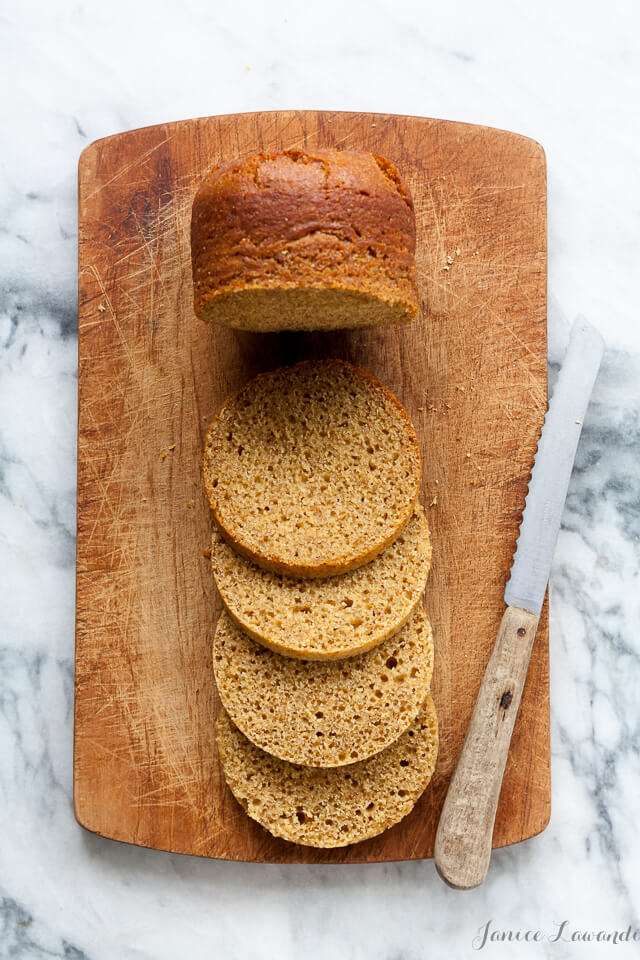
Is that scenario so hard to imagine? Plus, many Canadian coffee companies actually use cans that are a mixture of metal and cardboard, which probably isn't a very oven-safe combination and not too compatible with the water bath that the breads bake in. And I happen to get coffee from a local roaster, and he sells that coffee in paper bags, but I guess that's besides the point...
Bread steamed in a can vs baked
Can size aside, most brown bread recipes are baked in cans in a water bath in the oven for several hours but what I found here is that it takes a lot longer than the recommended 1.5 hours to get the submerged area to brown. Even after 2 hours, the browning of the bread still wasn't even. I also tried baking the bread directly in the oven, no water bath, which lead to a more even browning on the outside within an hour of baking, and I don't think the texture was any different from the breads baked in the water bath. So I don't think there's a point to the bain-marie technique, honestly.
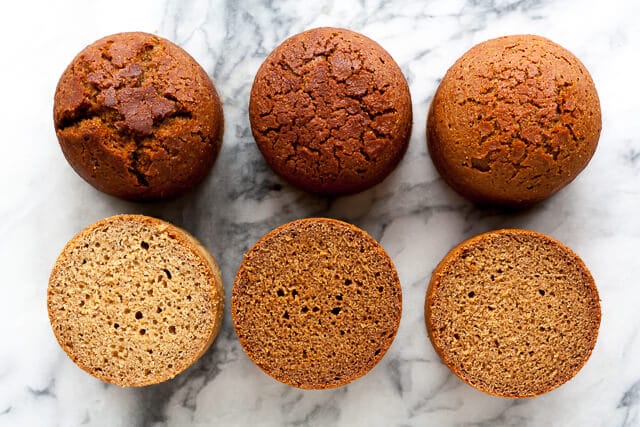
Still, I'd like to test out more brown bread recipes, or at least tweak this version here. I want to drastically reduce (if not remove) all that baking soda to see how that affects the flavour, and also to test out if the colour we are seeing is really a consequence of the Maillard browning reactions at alkaline pH or just caramelization. Plus, I'm just not sure a whole tablespoon of baking soda is necessary to get the pH high enough for browning reactions to occur. Recall baking soda is a leavening agent and we know too much baking soda in baking isn't necessarily a good thing. I keep meaning to buy pH paper and now I have yet another reason to invest. Still, this homemade Boston brown bread is a great no-knead bread recipe that I'll add to my repertoire of no-knead breads like the no-knead cinnamon raisin bread and the Irish soda bread with raisins.
All that to say this is why my letter to Bon Appétit will also suggest that they hire me, and if you are reading my post, editors of Bon Appétit, you can contact me via this form. If you want to see the results of some of my other baking experiments, check out my cake drop experiment, my sablé cookie experiment, my vanilla cake recipe comparison, and even my marmalade setting temperature experiment.
Quebec Boston brown bread recipe
This Boston brown bread recipe is another type of no-knead bread recipe that comes together like a quick bread or muffin, mixed with a wooden spoon and baked in coffee cans (or maple syrup cans in this case).
📖 Recipe
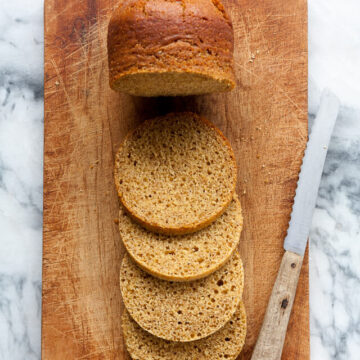
Boston Brown Bread (no yeast, no knead)
Equipment
Ingredients
- unsalted butter slightly melted, for greasing the cans
- 500 mL whole milk (3.25 % fat)
- 125 mL pure maple syrup medium or amber grade (for more flavour)
- 40 grams maple sugar
- ¾ teaspoon Diamond Crystal fine kosher salt
- 125 grams whole wheat all-purpose flour
- 156 grams bleached all-purpose flour
- 125 grams rye flour
- 52 grams cornmeal
- 1 tablespoon baking soda
- 1 teaspoon baking powder
Instructions
- Carefully grease the inside of three empty maple syrup cans using a pastry brush. Make sure to get butter in all the grooves. Set aside. Also cut three squares of foil to cover each can with, greasing one side with butter.
- Preheat the oven to 350 °F (175 °C).
- Heat the milk with the maple syrup, maple sugar, and salt until everything is dissolved (do not boil). Set aside to cool.
- In a large bowl, whisk together the flours, cornmeal, baking soda, and baking powder. Add the milk mixture and whisk until just smooth and combined.
- Divide the mixture between the three prepared cans. Top each with a piece of foil, grease-side down and secure with a piece of kitchen twine.
- Bake for about 1 hour on the middle rack.
Notes
Dimensions of 1 maple syrup can = 11.4 cm high x 8.9 cm diameter (4.5" x 3.5")

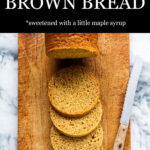
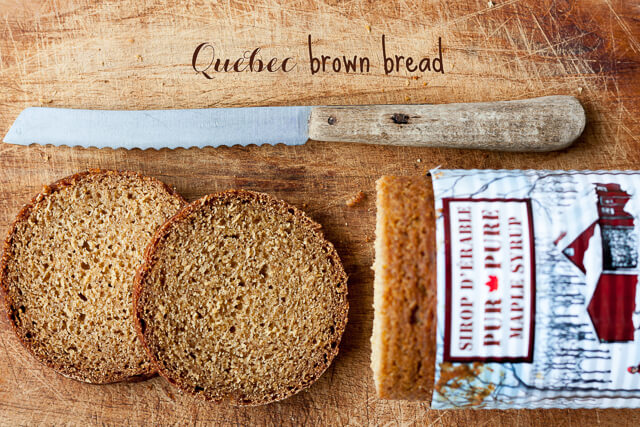
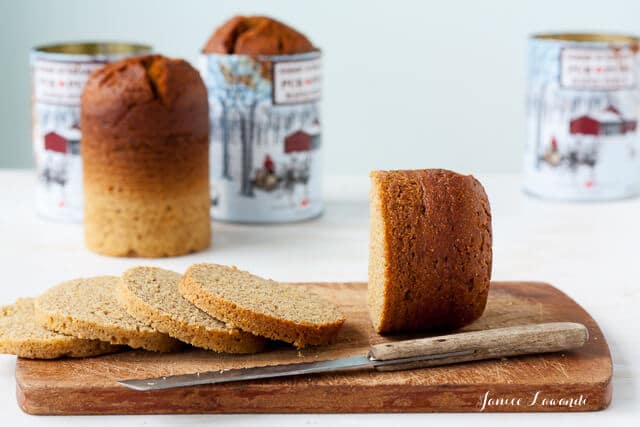
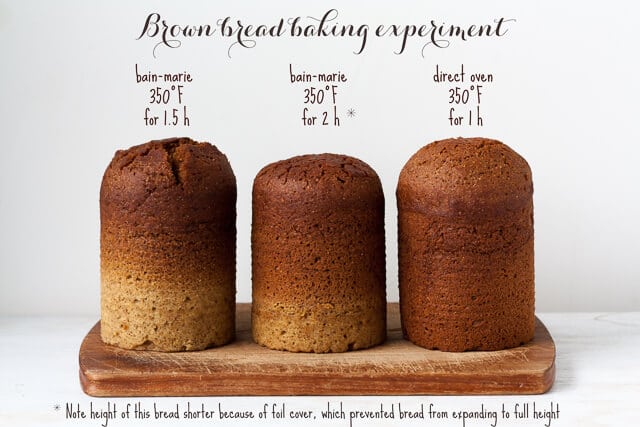
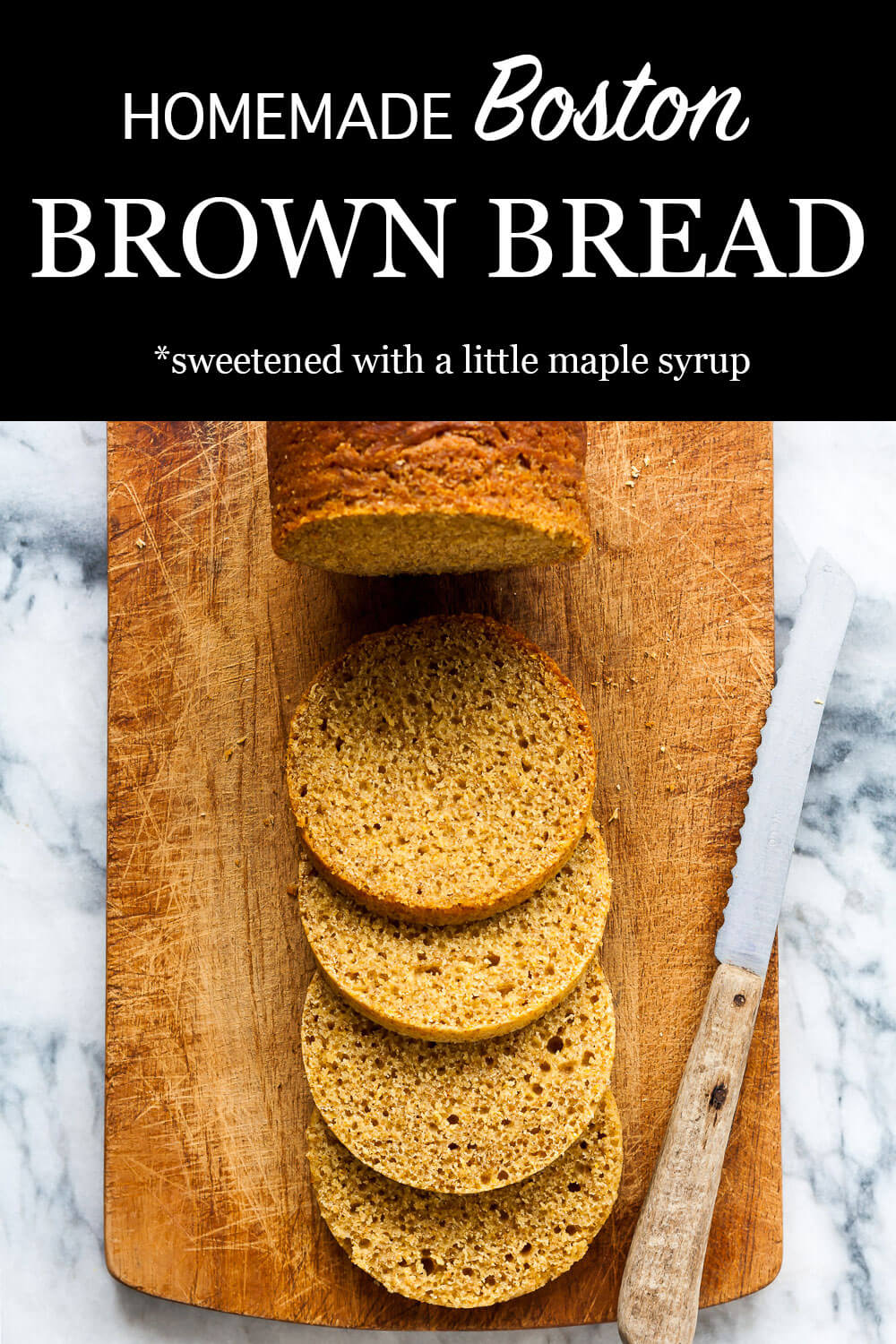
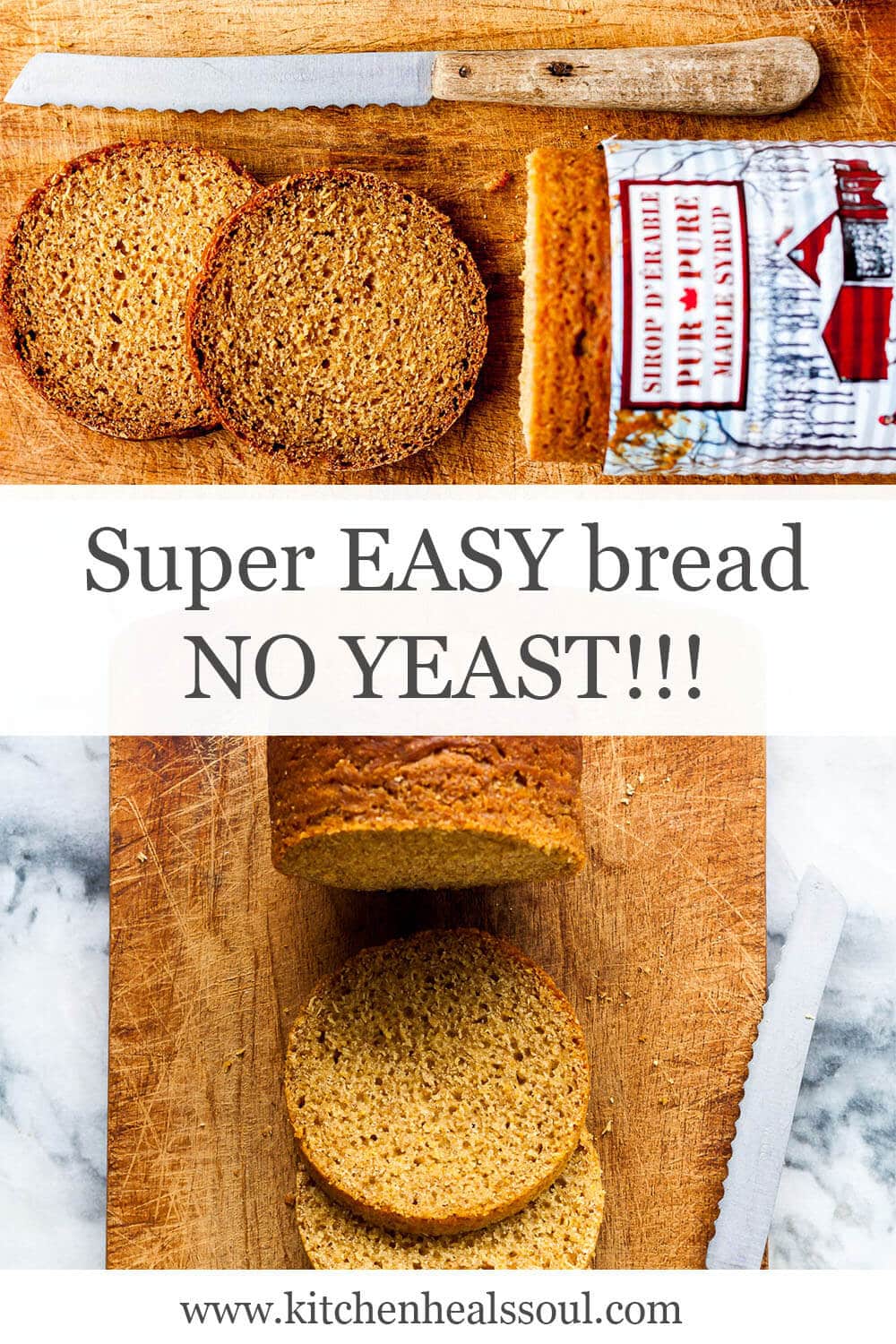
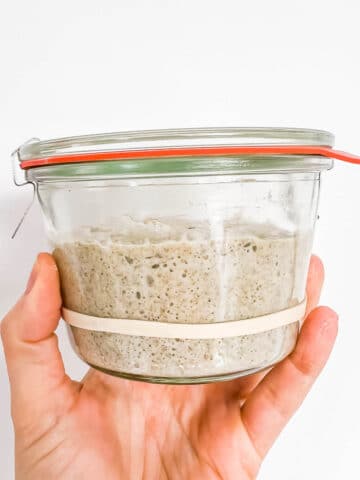
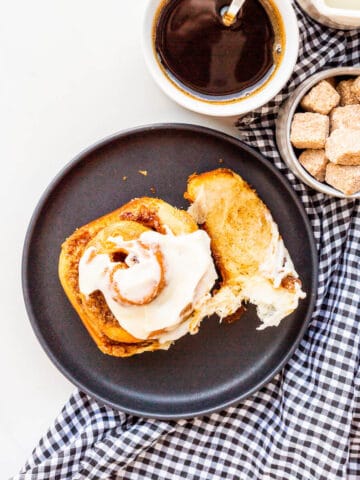
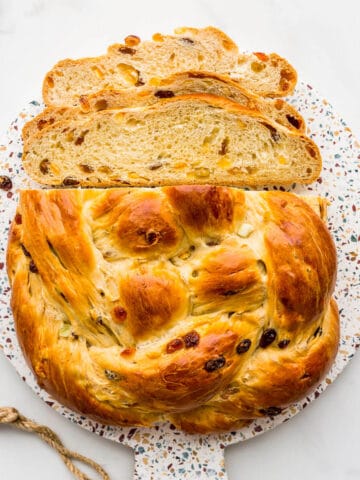
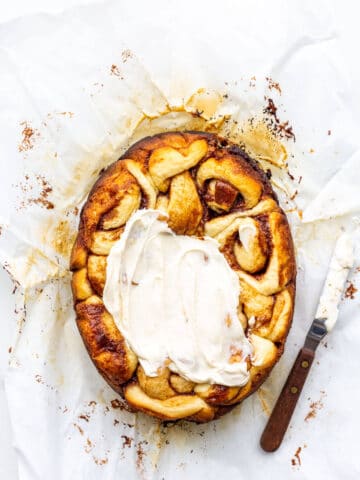
Steve says
I had to modify a bit-Moreno sugar instead of maple sugar. And I used some soup cans. Three of them. But the big thing I wanted to note that this makes three-380 gram loaves, which is convenient for evenly dividing the batter.
Cindy Wilsey says
I stumbled across this post this evening & enjoyed reading it. I am moved to leave these comments because I am intrigued to try your introduction of maple into the bread. First, my only negative impression of your work. You mix up bread batter using a volume of over 5 cups and the expect 2 baking molds totally about 3 cups to contain the volume. Both my old foods teacher and the old math tutor in me chide you for not thinking through your answer to the problem. To help you understand why the magazine editors used the designations that they did, you need to know that these were once upon a time known as 1# coffee cans from an era in which coffee in North America was only measured in pounds and ounces and all cans were all metal. Bread molds for Boston Brown bread were not inexpensive and by chance were about the same size as the old 1# coffee can. And, so it became common practice to re-use the coffee cans as bread molds.
Traditional brown bread rises using the interaction of baking soda and sour milk. No baking powder is needed. Also, it is steamed on the stove top until cooked through and finished in a moderate oven to dry it off. This means to 3 hours of steaming and a few minutes at 375 (190) to finish. The rich brown color of the traditional bread comes from the use of molasses as the only sweetener for the bread.
I am intrigued by your use of plain whole wheat flour because true graham flour (called for in my rather old recipe - circa 1939) is now almost impossible to find. I am also intrigued because you gave reduced the cornmeal. The texture of my old recipe is my only real complaint about it, and that texture comes from the volume of cornmeal. (Traditional recipes use equal volumes of cornmeal, rye and graham flours.)
Using my old recipe, I would suggest that you can eliminate the baking powder, reduce the baking soda to 3/4 teaspoon but increase the salt to 1 teaspoon. You could also likely be able to reduce the AP flour to no more than 1 full cup.
Finally, true brown bread must contain some molasses. Perhaps try mixing 1/2 cup maple syrup with 1/4 cup molasses. This is one of the reasons it goes to wonderfully well with Boston Baked Beans. Growing up we would often enjoy a meal of baked beans to which we added a generous amount of chopped onion cooked with 1# of browned bulk pork sausage. (These are known as Mom's Beans by those with whom I have shared the recipe over the decades.) Mom's Beans and brown bread with plenty of butter is soul satisfying and warming on chilly nights.
What follows is a recipe from 1939:
1 cup each rye flour, graham flour, and cornmeal
3/4 teaspoon baking soda
1 teaspoon salt
3/4 cup molasses
2 cups sour milk*
Mix and sift the dry ingredients. Combine the milk and molasses. Add wet to dry and beat thoroughly. Pour into well greased molds, filling them 2/3rds full. Loosely cover molds with squares of tea toweling. (Modern note: You need 2 cylindrical molds that each hold about 1 quart or 3 molds that each hold about 3 cups.) Place in steamer and cook 3 hours. (Modern note: the water should be at a simmer not at a boil) Remove the covers and bake in 375 degree oven long enough to dry it off.
*To sour milk, add 1 tablespoon distilled white vinegar to 1 cup less 1 tablespoon fresh milk and let stand 10 minutes.
I look forward to incorporating maple syrup into my recipe and replacing some of the cornmeal with AP flour.